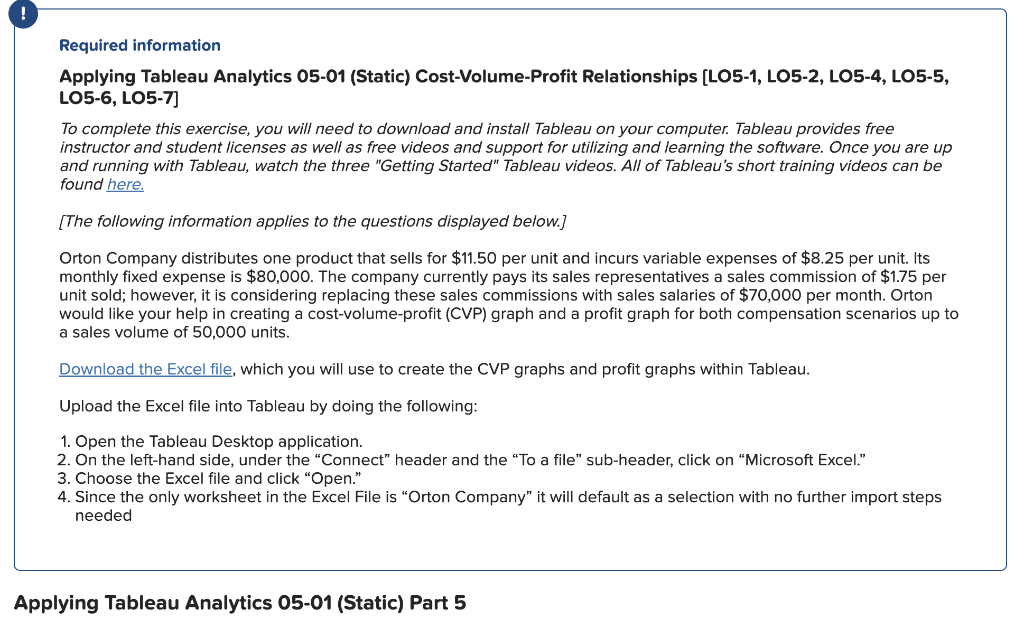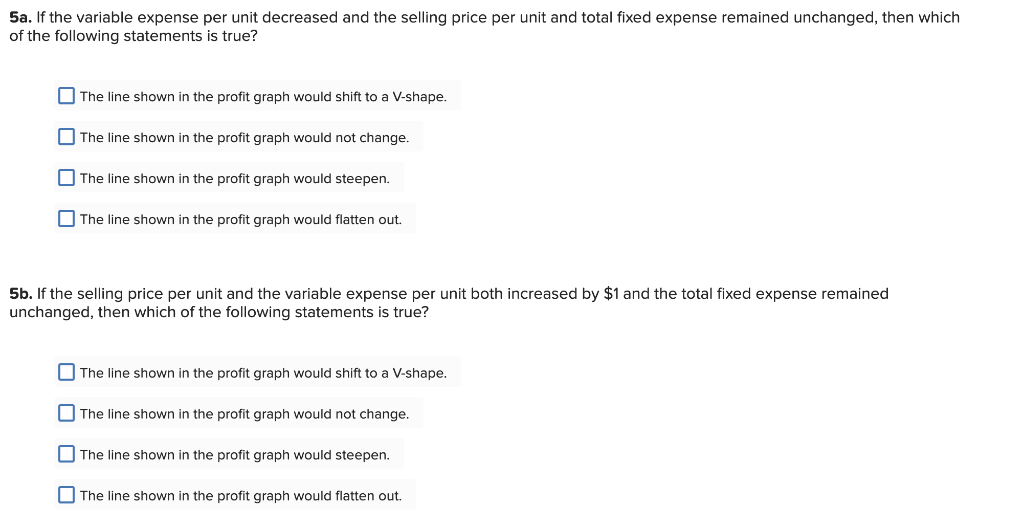


Applying Tableau Analytics 05-01 (Static) Cost-Volume-Profit Relationships [LO5-1, LO5-2, LO5-4, LO5-5, LO5-6, LO5-7] To complete this exercise, you will need to download and install Tableau on your computer. Tableau provides free instructor and student licenses as well as free videos and support for utilizing and learning the software. Once you are up and running with Tableau, watch the three "Getting Started" Tableau videos. All of Tableau's short training videos can be found here. [The following information applies to the questions displayed below.] Orton Company distributes one product that sells for $11.50 per unit and incurs variable expenses of $8.25 per unit. Its monthly fixed expense is $80,000. The company currently pays its sales representatives a sales commission of $1.75 per unit sold; however, it is considering replacing these sales commissions with sales salaries of $70,000 per month. Orton would like your help in creating a cost-volume-profit (CVP) graph and a profit graph for both compensation scenarios up to a sales volume of 50,000 units. Download the Excel file, which you will use to create the CVP graphs and profit graphs within Tableau. Upload the Excel file into Tableau by doing the following: 1. Open the Tableau Desktop application. 2. On the left-hand side, under the "Connect" header and the "To a file" sub-header, click on "Microsoft Excel." 3. Choose the Excel file and click "Open." 4. Since the only worksheet in the Excel File is "Orton Company" it will default as a selection with no further import steps needed Applying Tableau Analytics 05-01 (Static) Part 5 5a. If the variable expense per unit decreased and the selling price per unit and total fixed expense remained unchanged, then which of the following statements is true? The line shown in the profit graph would shift to a V-shape. The line shown in the profit graph would not change. The line shown in the profit graph would steepen. The line shown in the profit graph would flatten out. 5b. If the selling price per unit and the variable expense per unit both increased by $1 and the total fixed expense remained unchanged, then which of the following statements is true? The line shown in the profit graph would shift to a V-shape. The line shown in the profit graph would not change. The line shown in the profit graph would steepen. The line shown in the profit graph would flatten out. 5c. If the total fixed expense decreased and the selling price per unit and the variable expense per unit both remained unchangec then which of the following statements is true? The line shown in the profit graph would shift downward but its angle in relation to the X-axis (the horizontal axis) would not change. The line shown in the profit graph would shift downward and its angle in relation to the X-axis (the horizontal axis) would flatten out. The line shown in the profit graph would shift downward and its angle in relation to the X-axis (the horizontal axis) would steepen. The line shown in the profit graph would shift upward and its angle in relation to the X-axis (the horizontal axis) would steepen. Applying Tableau Analytics 05-01 (Static) Cost-Volume-Profit Relationships [LO5-1, LO5-2, LO5-4, LO5-5, LO5-6, LO5-7] To complete this exercise, you will need to download and install Tableau on your computer. Tableau provides free instructor and student licenses as well as free videos and support for utilizing and learning the software. Once you are up and running with Tableau, watch the three "Getting Started" Tableau videos. All of Tableau's short training videos can be found here. [The following information applies to the questions displayed below.] Orton Company distributes one product that sells for $11.50 per unit and incurs variable expenses of $8.25 per unit. Its monthly fixed expense is $80,000. The company currently pays its sales representatives a sales commission of $1.75 per unit sold; however, it is considering replacing these sales commissions with sales salaries of $70,000 per month. Orton would like your help in creating a cost-volume-profit (CVP) graph and a profit graph for both compensation scenarios up to a sales volume of 50,000 units. Download the Excel file, which you will use to create the CVP graphs and profit graphs within Tableau. Upload the Excel file into Tableau by doing the following: 1. Open the Tableau Desktop application. 2. On the left-hand side, under the "Connect" header and the "To a file" sub-header, click on "Microsoft Excel." 3. Choose the Excel file and click "Open." 4. Since the only worksheet in the Excel File is "Orton Company" it will default as a selection with no further import steps needed Applying Tableau Analytics 05-01 (Static) Part 5 5a. If the variable expense per unit decreased and the selling price per unit and total fixed expense remained unchanged, then which of the following statements is true? The line shown in the profit graph would shift to a V-shape. The line shown in the profit graph would not change. The line shown in the profit graph would steepen. The line shown in the profit graph would flatten out. 5b. If the selling price per unit and the variable expense per unit both increased by $1 and the total fixed expense remained unchanged, then which of the following statements is true? The line shown in the profit graph would shift to a V-shape. The line shown in the profit graph would not change. The line shown in the profit graph would steepen. The line shown in the profit graph would flatten out. 5c. If the total fixed expense decreased and the selling price per unit and the variable expense per unit both remained unchangec then which of the following statements is true? The line shown in the profit graph would shift downward but its angle in relation to the X-axis (the horizontal axis) would not change. The line shown in the profit graph would shift downward and its angle in relation to the X-axis (the horizontal axis) would flatten out. The line shown in the profit graph would shift downward and its angle in relation to the X-axis (the horizontal axis) would steepen. The line shown in the profit graph would shift upward and its angle in relation to the X-axis (the horizontal axis) would steepen









